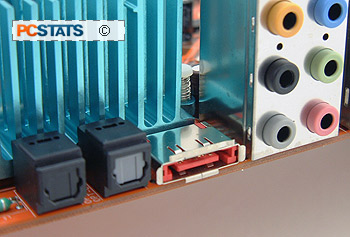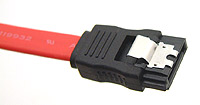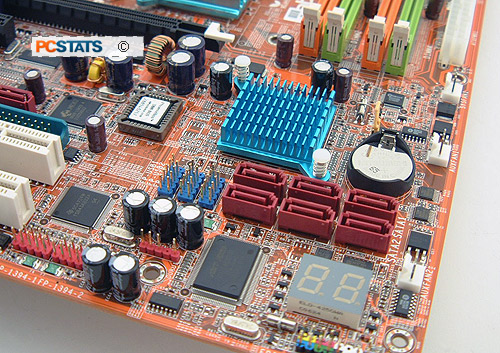 When it comes to external mass storage,
bandwidth has always been an issue, and Serial ATA makes even IEEE 1394b's
800Mbps bandwidth look paltry by comparison. The ABIT AB9 Pro motherboard has
one external SATA (eSATA).
When it comes to external mass storage,
bandwidth has always been an issue, and Serial ATA makes even IEEE 1394b's
800Mbps bandwidth look paltry by comparison. The ABIT AB9 Pro motherboard has
one external SATA (eSATA).
This connection uses a slightly modified SATA cable
(not included), which is better suited to external connections. Standard
internal Serial ATA cables are sufficient for internal connections, but SATA-IO
governing body decided a while back that the external version should be a
somewhat different format, thus creating the eSATA standard.
 eSATA enclosures for SATA hard
drives are widely available, and the great thing is that hard drives
connected over this standard are just as fast as internal devices. The
connectors are hot swappable, so it makes adding and removing an massive
external hard drive about as complex as plugging in a USB memory key. For anyone
who as ever had to move Gig's of data over a USB cable, eSATA is simply awesome.
eSATA enclosures for SATA hard
drives are widely available, and the great thing is that hard drives
connected over this standard are just as fast as internal devices. The
connectors are hot swappable, so it makes adding and removing an massive
external hard drive about as complex as plugging in a USB memory key. For anyone
who as ever had to move Gig's of data over a USB cable, eSATA is simply awesome.
The Port 80 Diagnostics card
The two digit Port 80 display is located right on the PCB, in the lower right
hand corner of the ABIT AB9 Pro motherboard next to the front panel I/O header.
It's the perfect tool for the tweaker in times of hardware trouble, the little
Port 80 device makes life a lot easier.
The standard that dictates what codes are displayed on the Port 80 card have been
around for years, and the main values are pretty much the same no matter what brand or model
of motherboard you use (if it has the card anyhow). Even if your motherboard
doesn't have one, it's possible to get a Port 80 diagnostics PCI card to install
into the system if you do a lot of troubleshooting.

Here's a quick rundown on the most common Port 80 errors
you may encounter when overclocking on the ABIT AB9 Pro motherboard. 'C1'
usually indicates a system memory problem, usually that the memory has been
overclocked too high for the computer to POST. 'C0' tells us that the L2 cache
on the processor is running too fast, a '26' error is a bit more vague but
usually indicates to enthusiasts that the system has overclocked too high and
cannot POST. 'FF' means hardware wise everything was able to pass the POST tests
although it's still possible for you to have other hardware stability
issues.
If you do run into problem with the ABIT AB9 Pro motherboard, the Port
80 should be the first thing you check. It's possible that it may display an
odd two digit value, so keep the user's manual handy because ABIT has a reference at the back of its user's manual of all the codes and what they mean.
